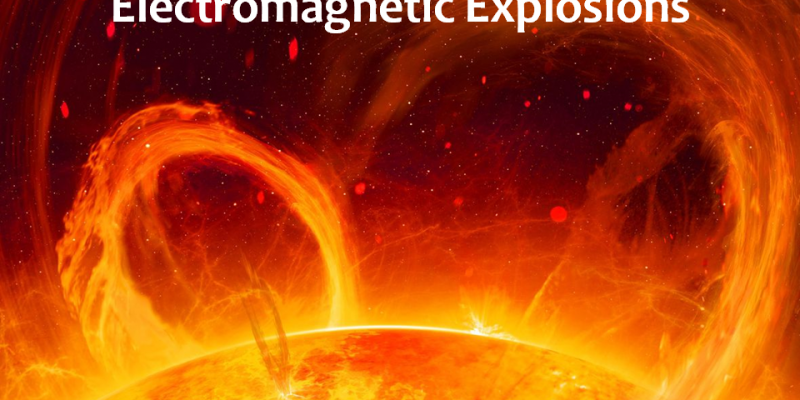
There is absolutely no doubt that the universe is full of fascination. From Black Holes to the Dark Matter to Exoplanets and whatnot, the theory behind such fabulous phenomena is just mind-blowing. This blog will take you through yet another amazing and perplexing phenomenon, SOLAR FLARES.
What are solar flares exactly, and what makes them so powerful? Are there ways to predict their occurrence? Read on to find answers to these intriguing questions.
What are solar flares?
Basically, a solar flare is a massive explosion of electromagnetic radiation of the Sun, developed by the sudden release of the energy stored in magnetic fields above the sunspots, and this eruption of electromagnetic energy travels at the speed of light.
But what do these solar flares eject? – High-energy particles, streams of electrons, hard X-rays, and radio bursts. When the flare comes in contact with the interplanetary medium, shock waves are produced. The lower layers of the ionosphere in the sunlit part of the Earth are ionized due to X-rays and the extreme ultraviolet (EUV) radiations.

Image Credit: sm.mashable.com
Solar flares are associated with massive amounts of energy, but why aren’t they visible on Earth? Despite the great energy involved, most flares are almost invisible in ordinary light because the energy release takes place in the transparent atmosphere.
Now the question arises: If flares are invisible on Earth, then how was research even possible? How did scientists derive conclusions and come up with fascinating theories on Solar Flares?
There are certain regions where flares are visible, called the H (α) region, where the brightness of the flare just shoots up dramatically. To our surprise, in this region, a big flare will cover a few thousandths of the Sun’s disk, definitely out of our imagination. That’s how massive they are! In contrary to this, in white light, only a few small bright spots appear.
There is another incredible fact about Solar Flares, which is absolutely breathtaking! The energy associated with flares is almost equal to the output of the entire Sun. Isn’t it mind-blowing?
Flares, which are quite large, usually occur in association with large sunspots that have jarring magnetic variations and carry exponentially large currents. These are often the source of the flare energy.
The energy deposited on the surface of a gives rise to a super-hot cloud, and guess what the temperature of the cloud could be? It is an unimaginable 100 million Kelvin. Probably, most of us wouldn’t have even heard about the existence of such super-hot species. They usually occur in the corona, which is a strong and long-lasting source of X-rays.
Solar flares range from giant events that shower the surface of the Earth with massive particles to the ones that are barely detectable.
How were solar flares first detected?
For a very long time in history, solar flares were unknown because flare-monitoring telescopes were poor in terms of computational power and resolution. For the very first time in 1960, German astronomer Horst Künzel recognized that a special kind of spot was responsible for the occurrence of most of the solar flares called the δ spot.
But how could these δ spots produce such massive sun flares? While most sunspots have a single magnetic polarity, a δ spot has two or more umbra of opposite polarity within the same penumbra. When these groups of opposite polarity magnetic fields come in contact, a steep variation in the magnetic field is produced, which has the potential to store massive amounts of energy and ultimately leads to the formation of solar flares.
Now, we know how massive and immense solar flares are some mind-boggling questions would definitely trigger us!
Will solar flares destroy Earth in the future?
Providentially, no matter how large the flare is or where it has occurred, flares do not have a significant effect on Earth. There can be measurable effects at ground level, but the amount of radiation is quite insignificant. The Earth’s atmosphere acts as a shield to prevent cosmic radiation from reaching us. Well, this is not to say that space weather cannot affect our planet.
The explosive heat of a solar flare certainly cannot impact the entire globe, but the electromagnetic radiations and highly energized particles associated with solar flares certainly can do so. Solar flares can temporarily alter the upper atmosphere, creating disruptions with signal transmission and communication.
These radiations might also interact with onboard satellites causing their destruction, which means they could probably destroy a GPS satellite to Earth, resulting in loss of signal transmission and connectivity. The world today is highly driven by technological advancements, and communication plays a crucial part right from our cell phones to airplane navigation. In such a scenario, the impact caused by solar flares has become a matter of concern.
What is the effect of solar flares on the Martian Surface?
Quite interesting question! The Martian Surface experiences serious consequences as compared to that of Earth. Studies show that Solar Flares caused Mars’s upper atmosphere to heat unevenly.
In areas where the atmosphere heated up significantly, the top two layers of the upper atmosphere, called the thermosphere and ionosphere, interacted with each other in response to the flare, which caused molecular oxygen (O2) to escape into space at a much higher rate than normal.
It caused a substantial decrease in the amount of oxygen in the Martian atmosphere, which is definitely devastating. Now that we know how Solar Flares have varied effects across the universe. Let’s dive deep and get an idea about how they are actually formed!
Formation of solar flares
Originally, it was very difficult to detect the magnetic changes in the vicinity of flares because it is the transverse component of the field that changes, and variations in the horizontal field are extremely difficult to measure.
The predicament of the transverse component of the magnetic field
The transverse component of the magnetic field is perpendicular to the line of sight, which makes measurement difficult. Magnetographs are generally built only for special experiments and are not preferred for common use.
Another challenge here is to measure the transverse component of the magnetic field, and this change in the horizontal field can be measured with an ordinary continuous magnetograph when the flare is at the edge of the Sun. This would ensure that the field lines point towards the surface of the Earth.
Magnetic fields have a minimum energy state called a potential field, which is smooth and without sheer variations. When the field is twisted or sheared by the application of an external material motion, the field becomes capable of storing additional energy in electrical currents sustaining these fields, and the energy is appallingly released in solar flares.
Impulsive flares are often accompanied by outward explosion and ejection of coronal material. This material may be carried far away from the vicinity of the sun flare with the erupting magnetic field or may be ejected by the high pressure in the flare.
The highest recorded speed of a solar flare is 1,500 kilometers per second. It’s bewildering, isn’t it? The typical speed of sun flares is about 100–300 kilometers per second. A substantial part of solar wind is made up of the great clouds of coronal material that are blown out of these flares.
And that’s how massive and fascinating solar flares are!

Image Credit: NASA
Suggested Reading: Supermassive Black Hole and the swirling magnetic field
Author












